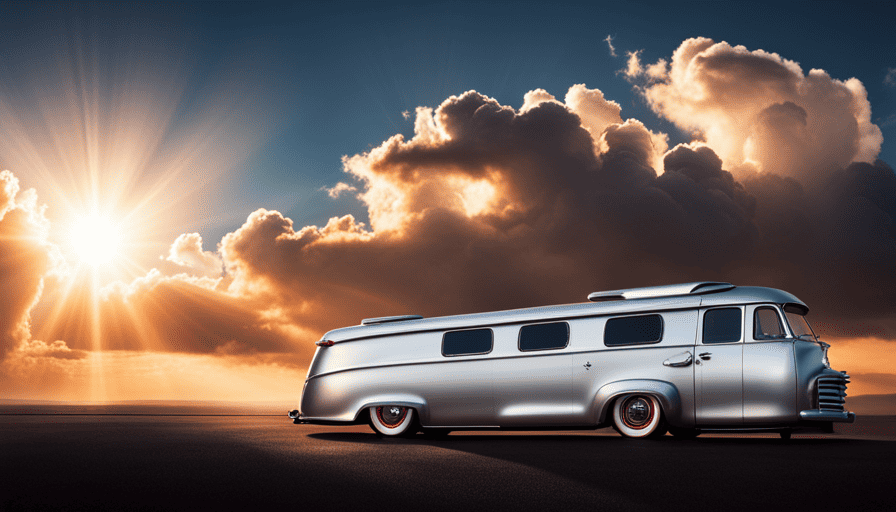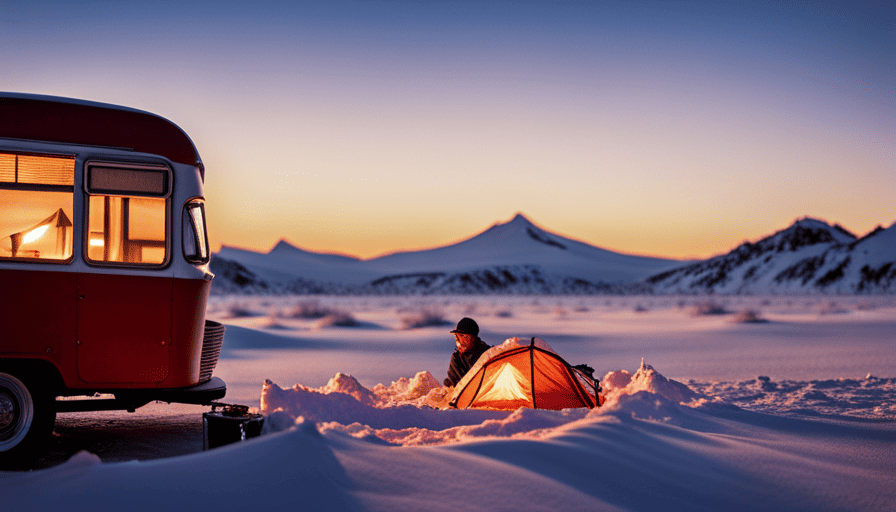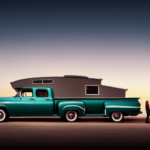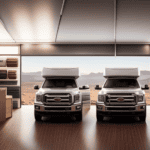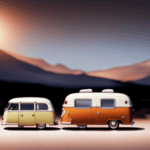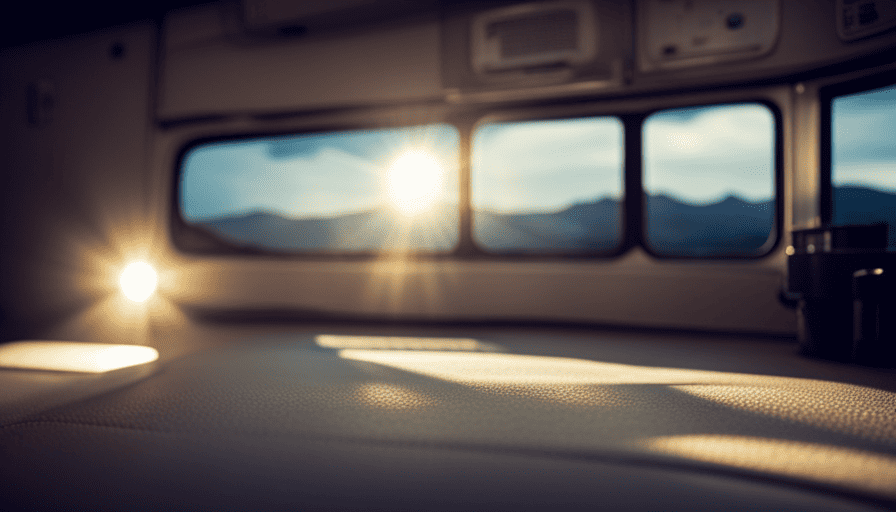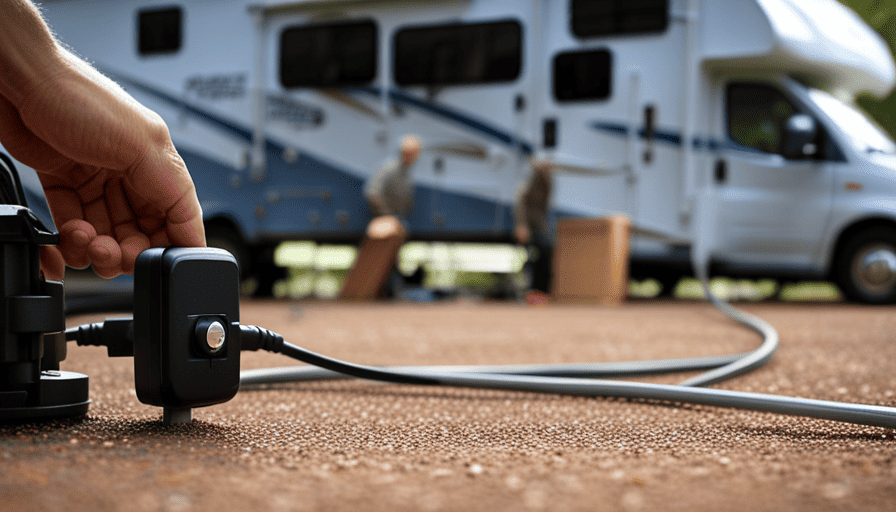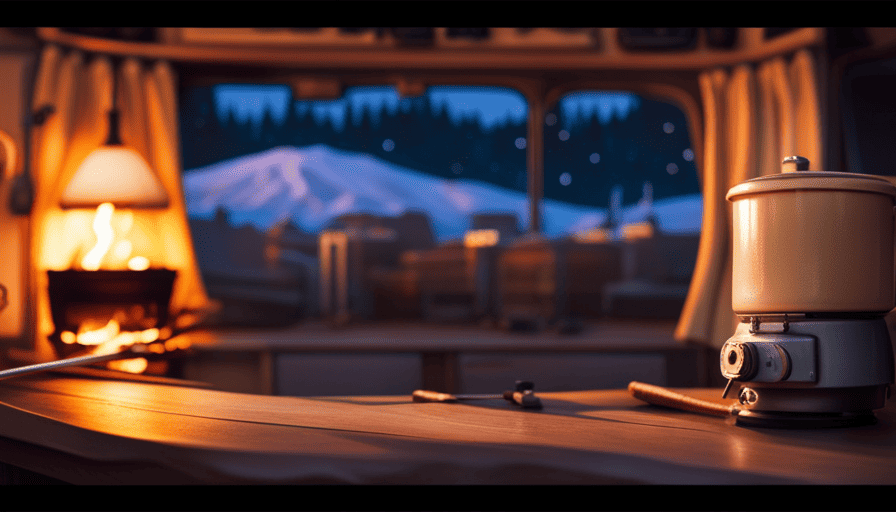Thinking about installing a camper shell on your truck? It’s crucial to understand that it involves more than just attaching it and hitting the road. In fact, there are several factors to consider when it comes to the cost of a camper shell.
But don’t you worry, I’ve got all the information you need right here.
In this article, we’re going to dive deep into the world of camper shells and explore the different types available, the factors that influence their cost, and even some tips for finding the best deal.
We’ll also discuss financing options, and for those DIY enthusiasts out there, we’ll even explore a cost-saving alternative.
So whether you’re a seasoned camper or just starting out, sit back and relax as we break down everything you need to know about how much a camper shell will set you back. Trust me, you won’t want to hit the road without this knowledge.
Key Takeaways
- The cost of a camper shell can vary depending on factors such as the material, brand, size, additional features, and customization options.
- Basic camper shells typically range from $500 to $2,000, while those with more features and customization options can cost $2,000 to $4,000 or more.
- Used camper shells are generally cheaper but may have limited options and signs of wear and tear, while new camper shells offer warranty coverage and more customization options but are more expensive.
- In addition to the cost of the camper shell itself, buyers should also consider additional costs such as professional installation, window installation, roof rack installation, storage compartment installation, and custom paint jobs.
Types of Camper Shells Available
There’s a wide variety of camper shells available, so you’ll have plenty of options to choose from! When it comes to types of camper shell materials, you’ll find options such as fiberglass, aluminum, and composite.
Fiberglass shells are popular due to their durability and sleek design. They’re resistant to rust and can withstand harsh weather conditions.
Aluminum shells, on the other hand, are lightweight and offer excellent fuel efficiency. They’re also known for their strength and durability.
Composite shells combine the best of both worlds, offering a lightweight construction with the strength and durability of fiberglass.
In terms of popular camper shell brands, there are several well-known names in the market. Some of the top brands include Leer, SnugTop, and ARE. These brands have established themselves as leaders in the industry, offering high-quality camper shells with a wide range of features and options to choose from.
Factors that influence the cost of a camper shell include the material, brand, size, and additional features. By considering these factors, you can find a camper shell that fits your needs and budget.
Factors That Influence the Cost
One factor that can impact the price of a camper shell is the specific features it offers, such as extra storage compartments or a built-in roof rack. These features can add convenience and functionality to the camper shell, but they can also increase its price. Additionally, customization options can also affect the cost of a camper shell. Some manufacturers offer the option to customize the shell to fit specific truck models or to match the color of the truck. These customization options can add a personal touch to the camper shell, but they may come with an additional cost.
To help you better understand the factors that influence the cost of a camper shell, here is a table outlining some common features and customization options along with their potential impact on the price:
| Feature/Customization Option | Impact on Price |
|---|---|
| Extra storage compartments | Higher price |
| Built-in roof rack | Higher price |
| Custom fit for specific truck | Higher price |
| Color matching | Higher price |
| Paint protection | Higher price |
Considering these factors, it is important to carefully evaluate your needs and preferences when choosing a camper shell. In the next section, we will discuss the average price range for camper shells, providing you with a better understanding of what to expect in terms of cost.
Average Price Range for Camper Shells
The price range for camper shells varies depending on the features and customization options chosen. On average, a basic camper shell can cost anywhere from $500 to $2,000. This price range typically includes a standard shell with minimal features such as a rear door and side windows.
As you start adding more features and customization options, the price can increase significantly. For example, camper shells with additional windows, roof racks, interior lighting, and insulation can range from $2,000 to $4,000 or more. The cost can also be influenced by factors such as the size and type of the truck bed, the material used for the shell (aluminum or fiberglass), and the brand reputation.
It’s important to consider your specific needs and budget when choosing a camper shell.
Transitioning into the subsequent section about ‘used vs. new camper shells’, it’s worth exploring the options available in both the new and used markets to find the best fit for your requirements and budget.
Used vs. New Camper Shells
When considering a camper shell, you’ll want to weigh the benefits and cost savings of buying used versus the advantages of purchasing new. Here are some pros and cons of each option:
-
Used camper shells:
-
Pros:
- Lower cost: Used shells are generally cheaper than new ones.
- Immediate availability: You can find used shells easily and quickly.
- Customization potential: Used shells may already have modifications that suit your needs.
- Less depreciation: Used shells have already experienced some depreciation, so you won’t lose as much value if you decide to sell it later.
-
Cons:
- Limited options: You may have to compromise on color, size, or features since used shells are dependent on what’s available in the market.
- Potential wear and tear: Used shells may have signs of wear and tear, which could affect their functionality and durability.
-
New camper shells:
-
Pros:
- Warranty coverage: New shells often come with a warranty, providing additional peace of mind.
- Customization options: You can choose the exact specifications and features you want.
- Longer lifespan: New shells are less likely to have any pre-existing damage or wear.
- Better condition: You can expect a new shell to be in pristine condition.
-
Cons:
- Higher cost: New shells are generally more expensive than used ones.
- Longer wait time: It may take some time for a new shell to be manufactured and delivered.
Considering the pros and cons of used vs. new options, you can make an informed decision based on your budget and preferences. Now, let’s delve into the additional costs to consider.
Additional Costs to Consider
Considering the pros and cons of used vs. new options, it’s important to keep in mind that there can be hidden costs that can add up, like a wolf in sheep’s clothing. When buying a camper shell, there are additional installation costs that you need to consider. While some camper shells may come with a DIY installation option, it’s recommended to have it installed by a professional to ensure a proper fit and avoid any future issues. This can incur an extra cost, but it will be worth it in the long run.
Moreover, customization options are another factor to consider. Depending on your needs and preferences, you may want to add features such as windows, storage compartments, or even a roof rack. These customization options can significantly enhance the functionality and aesthetics of your camper shell but will also come at an additional cost.
To help you better understand the potential costs involved, here is a table outlining some common additional costs to consider when purchasing and installing a camper shell:
| Additional Costs | Price Range ($) |
|---|---|
| Professional Installation | $200 – $500 |
| Window Installation | $100 – $300 |
| Roof Rack Installation | $150 – $400 |
| Storage Compartment Installation | $100 – $250 |
| Custom Paint Job | $300 – $800 |
In addition to the base price of the camper shell, these costs can quickly add up. Therefore, it’s crucial to factor them into your budget when making a decision.
Moving on to the next section about where to buy camper shells, it’s important to explore different options to find the best deal.
Where to Buy Camper Shells
When it comes to buying camper shells, there are several options available to consider. Dealerships and retailers offer a wide range of options and provide the convenience of seeing the products in person.
Online marketplaces, on the other hand, offer a vast selection and the ability to compare prices and read reviews.
Lastly, local classifieds and forums can be a great resource for finding used camper shells at a potentially lower cost.
Dealerships and retailers
Dealerships and retailers offer a variety of camper shells to enhance your truck’s functionality and style. When shopping for a camper shell, it is important to consider the options available at different dealerships. Comparison shopping allows you to find the best deal and ensure that you are getting the right camper shell for your truck.
To emphasize the importance of dealership options, consider the following table:
| Dealership | Price Range | Availability |
|---|---|---|
| ABC Motors | $500-$1,000 | Limited |
| XYZ Trucks | $1,000-$1,500 | Wide |
| 123 Auto | $1,500-$2,000 | Moderate |
| QRS Motors | $2,000-$2,500 | Limited |
| DEF Trucks | $2,500-$3,000 | Wide |
By comparing prices and availability at different dealerships, you can make an informed decision and find the camper shell that suits your needs and budget. Moving forward, let’s explore the options available on online marketplaces.
Online marketplaces
Online marketplaces offer a plethora of options to transform your truck into a versatile and stylish masterpiece, with prices that will blow your mind. When shopping online for a camper shell, it’s important to consider the reviews and testimonials from previous customers. These can give you an insight into the quality and durability of the product you’re interested in. Many online marketplaces provide a rating system, allowing customers to leave feedback and share their experiences. This information can be invaluable when making a decision.
Additionally, some marketplaces offer detailed descriptions and specifications, helping you find the perfect fit for your truck. As you explore the world of online marketplaces, you’ll soon discover the vast array of options available to you.
In the next section, we’ll delve into the benefits of exploring local classifieds and forums.
Local classifieds and forums
After exploring online marketplaces for camper shell options, I decided to also check out local classifieds and forums. These platforms are great for finding deals in my area and connecting with sellers directly.
I found a few local listings for camper shells that caught my eye. One of the advantages of using local classifieds is the opportunity for face-to-face negotiations. I was able to meet with the sellers in person and discuss the price, condition, and any additional features of the camper shells. Negotiation tactics such as offering a lower price or asking for a package deal can sometimes lead to a better deal.
By utilizing local classifieds and forums, I was able to find more options and have a chance to negotiate. Now, let’s move on to some tips for finding the best deal on a camper shell.
Tips for Finding the Best Deal
When looking for the best deal on a camper shell, there are a few key points to keep in mind.
First, it’s important to research and compare prices from different retailers to ensure you’re getting the best price possible.
Additionally, keep an eye out for sales and promotions, as these can often save you a significant amount of money.
Lastly, consider buying during the off-season when demand is lower, as this can often result in lower prices as well.
Research and compare prices
To find the perfect camper shell, imagine yourself exploring various stores and comparing prices, helping you make an informed decision. Start by comparing the features of different camper shells to determine which one suits your needs best.
Look for features such as durability, insulation, and ease of installation. Factors that affect camper shell prices include the material used and the brand. Fiberglass shells tend to be more expensive than aluminum ones, for example. Additionally, well-known brands often come with a higher price tag.
By researching and comparing prices, you can find a camper shell that meets your requirements within your budget. Once you have gathered this information, you can then move on to the next step of looking for sales and promotions, where you may find even better deals.
Look for sales and promotions
Check it out, savvy shopper! Keep your eyes peeled for killer sales and promotions that can score you the ultimate deal on your dream camper shell.
Here are some discounts available to help you save big:
-
Manufacturer promotions: Many camper shell manufacturers offer limited-time promotions, such as discounts or free accessories, that can significantly reduce the overall cost.
-
Holiday sales: Keep an eye out for holiday sales, like Memorial Day or Labor Day, when retailers often offer special discounts on camper shells.
-
Clearance events: Retailers may have clearance events to make room for new inventory, giving you the opportunity to snag a camper shell at a discounted price.
-
Bundle deals: Some retailers offer bundle deals where you can purchase a camper shell along with other accessories, like roof racks or bed liners, at a discounted rate.
By taking advantage of sales and promotions, you can find a great deal on a camper shell. Consider buying during the off-season to maximize your savings.
Consider buying during the off-season
Don’t miss out on incredible savings by purchasing your dream camper shell during the off-season! Buying during the off-season can be a smart move when it comes to finding the best deals on camper shells. Many retailers offer discounts and promotions during this time to attract buyers.
Additionally, the demand for camper shells tends to be lower during the off-season, which means you may have more negotiating power when it comes to the price. Make sure to do your research and compare prices from different sellers to ensure you’re getting the best possible deal.
Once you’ve found the perfect camper shell, you can explore financing options to make your purchase even more affordable. Now, let’s dive into the various financing options available for camper shells.
Financing Options for Camper Shells
Unfortunately, there’s no escaping the irony that financing options for camper shells can often be as elusive as finding a unicorn riding a rainbow.
When it comes to financing your camper shell, it’s important to explore all available options and carefully consider the cost comparison. Here are a few key factors to keep in mind:
-
Traditional financing: Many dealerships offer financing options for camper shells, allowing you to make monthly payments over a set period of time. This can be a convenient choice if you prefer a structured payment plan.
-
Personal loans: Another option is to secure a personal loan from a bank or credit union. This can give you more flexibility in terms of repayment and may offer lower interest rates compared to dealership financing.
These financing options can be an emotional rollercoaster for anyone dreaming of the perfect camper shell. However, it’s crucial to weigh the pros and cons of each choice and consider your own financial situation before making a decision.
Now, let’s delve into another cost-saving alternative: DIY camper shells.
DIY Camper Shells: Cost-Saving Alternative
Creating your own camper shell can be a cost-effective and rewarding alternative to traditional financing options. DIY camper shell installation allows you to customize your shell to fit your specific needs and preferences, all while saving money. However, it’s important to weigh the pros and cons before embarking on this project.
To help you make an informed decision, here is a table outlining the advantages and disadvantages of building your own camper shell:
| Pros | Cons |
|---|---|
| Cost savings | Time-consuming |
| Customization options | Requires DIY skills |
| Sense of accomplishment | Potential for mistakes |
By building your own camper shell, you can potentially save a significant amount of money compared to purchasing one. Additionally, you have the freedom to design and customize the shell to meet your specific needs, whether it’s extra storage space or special features.
However, it’s important to note that building a camper shell requires time, effort, and DIY skills. It can be a challenging and time-consuming project, especially if you are not familiar with construction or carpentry. There is also a risk of making mistakes along the way, which could impact the overall functionality and durability of the shell.
While DIY camper shell installation offers cost savings and customization options, it also requires time, skills, and carries the risk of errors. Consider your abilities and available resources before deciding whether to build your own camper shell or explore other financing options. Next, we will discuss some final thoughts and considerations when it comes to camper shells.
Final Thoughts and Considerations
Before making a decision, take a moment to reflect on the overall benefits and potential challenges of building your own camper shell.
Remember, ‘measure twice, cut once’ to ensure a successful and satisfying DIY project.
When it comes to cost-saving options, building your own camper shell can be a great way to save money. By sourcing materials and doing the work yourself, you can significantly reduce the overall cost compared to buying a brand new camper shell.
Additionally, there is a second-hand market for camper shells, where you can find pre-owned ones at a fraction of the cost. This can be a viable option if you are on a tight budget and willing to put in the effort to refurbish and customize the shell to fit your needs.
However, it is important to consider the potential challenges of building your own camper shell. It requires time, skill, and knowledge of carpentry and design. If you’re not experienced in these areas, it may be more cost-effective and time-efficient to purchase a ready-made camper shell.
Ultimately, the decision to build your own camper shell should be based on your budget, skills, and willingness to invest time and effort into the project.
Frequently Asked Questions
How much does installation of a camper shell typically cost?
The average price of camper shell installation can vary depending on various factors such as the type of vehicle, the complexity of the installation, and the location. However, on average, you can expect to pay between $200 to $500 for camper shell installation. It’s important to note that this cost doesn’t include the price of the camper shell itself. To get an accurate estimate, it’s best to consult with a professional installer who can provide a more specific quote based on your unique requirements.
Are there any specific weight restrictions or limitations when using a camper shell?
When using a camper shell, it’s important to consider weight restrictions and limitations. These can vary depending on the specific camper shell and the vehicle it’s being installed on. It’s crucial to consult the manufacturer’s guidelines or contact a professional to determine the maximum weight capacity and any limitations that may apply.
This ensures the safe and proper use of the camper shell and prevents any potential damage to the vehicle.
Can a camper shell be customized or modified to fit specific needs?
Customizing a camper shell is like transforming a plain canvas into a masterpiece. There are numerous customization options available, allowing you to tailor the shell to your specific needs.
From added storage compartments to reinforced roofing, the benefits of a modified camper shell are endless. You can create a personalized space that maximizes functionality and suits your lifestyle perfectly.
With customization, your camper shell becomes a versatile and efficient travel companion.
Are there any maintenance or upkeep costs associated with owning a camper shell?
There are maintenance costs associated with owning a camper shell. Regular cleaning and inspections are necessary to ensure its lifespan and durability. This includes washing the shell to remove dirt and debris, checking for any cracks or damage, and lubricating hinges and locks.
Additionally, maintaining the sealant around the edges is crucial to prevent leaks. These routine upkeep tasks are essential to keeping the camper shell in good condition and prolonging its lifespan.
Are there any legal requirements or regulations for using a camper shell on a vehicle?
When it comes to using a camper shell on a vehicle, there are indeed legal requirements and regulations that need to be followed.
These rules vary from state to state and may include restrictions on the height of the camper shell, proper installation, and the use of safety features like brake lights.
It’s important to familiarize yourself with your state’s specific laws to ensure compliance and avoid any potential legal issues.
What Is the Cost of a Teardrop Camper Compared to a Camper Shell?
When it comes to teardrop camper pricing versus camper shells, there is a noticeable difference. Teardrop campers tend to be more expensive due to their compact size, built-in features, and overall convenience. On the other hand, camper shells are generally less expensive as they are just an empty shell that you can customize according to your needs.
Conclusion
In conclusion, the cost of a camper shell can vary depending on several factors such as the type, condition, and additional features. On average, camper shells can range from $500 to $3000.
However, it’s important to consider the additional costs such as installation, customization, and maintenance. To find the best deal, it’s advisable to explore both new and used options, and consider financing options if needed.
Alternatively, for those seeking a cost-saving alternative, DIY camper shells can be a rewarding project. Remember, finding the perfect camper shell is like finding a hidden treasure on a long road trip, adding excitement and adventure to your outdoor experiences.

